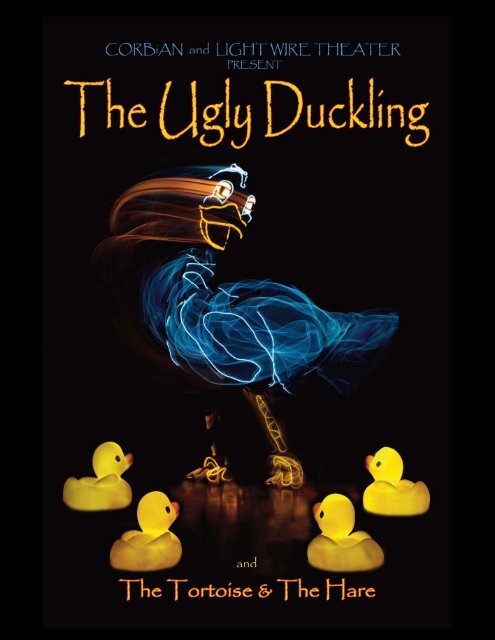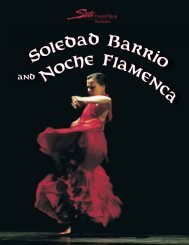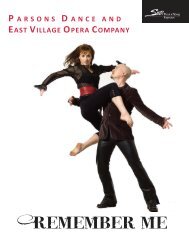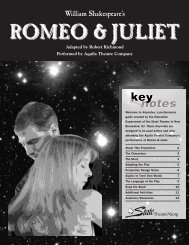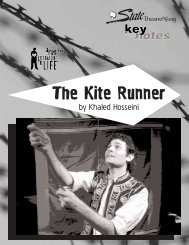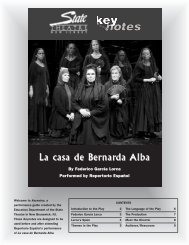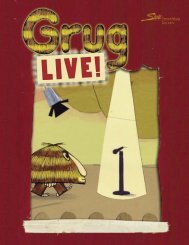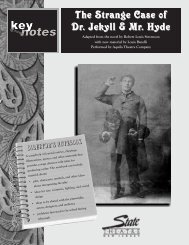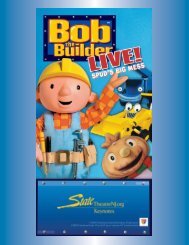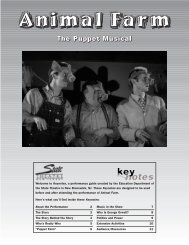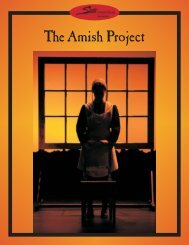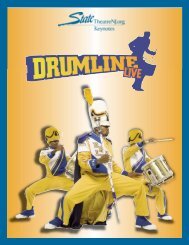Ugly Duckling Keynotes:Layout 1.qxd - State Theatre
Ugly Duckling Keynotes:Layout 1.qxd - State Theatre
Ugly Duckling Keynotes:Layout 1.qxd - State Theatre
- No tags were found...
You also want an ePaper? Increase the reach of your titles
YUMPU automatically turns print PDFs into web optimized ePapers that Google loves.
Welcome!2Welcome to the <strong>State</strong> <strong>Theatre</strong>’s performance of The <strong>Ugly</strong><strong>Duckling</strong> & The Tortoise and the Hare by Corbian and Light WireTheater. The production features high-tech special effects and anevocative musical score to bring to life two popular children’sstories.These <strong>Keynotes</strong> provide information and activities to prepareyour students for the performance and then help you lead them toreflect afterward on what they saw and heard in the show.See you at the <strong>State</strong> <strong>Theatre</strong>!ContentsWelcome!................................................................................................................2About the Show....................................................................................................3The <strong>Ugly</strong> <strong>Duckling</strong> ..............................................................................................4Hans Christian Andersen ..................................................................................5The Tortoise and the Hare................................................................................6Aesop........................................................................................................................7What’s the Difference? ......................................................................................8How Does It Work? ............................................................................................9What’s My Job at the Show? ........................................................................10<strong>Keynotes</strong> are produced by the Education Department of the <strong>State</strong><strong>Theatre</strong>, New Brunswick, NJ.Mark W. Jones, President & CEOLian Farrer, Vice President for EducationOnline at www.<strong>State</strong><strong>Theatre</strong>NJ.org/<strong>Keynotes</strong><strong>Keynotes</strong> for The <strong>Ugly</strong> <strong>Duckling</strong> & The Tortoise and the Harecreated by Lian Farrer and Jennifer Cunha.© 2013 <strong>State</strong> <strong>Theatre</strong>Find us at www.<strong>State</strong><strong>Theatre</strong>NJ.orgContact: education@<strong>State</strong><strong>Theatre</strong>NJ.org<strong>State</strong> <strong>Theatre</strong>, a premier nonprofit venue for the performing artsand entertainment.The <strong>State</strong> <strong>Theatre</strong>’s education program is funded in part by Colgate-Palmolive, Cream-O-Land Dairy, E & G Foundation, Great-West Life &Annuity Insurance Company, The Horizon Foundation for New Jersey,Ingredion, Johnson & Johnson Family of Companies, J. Seward Johnson, Sr.1963 Charitable Trust, Karma Foundation, The Blanche and Irving LaurieFoundation, McCrane Foundation, MetLife Foundation, New Jersey <strong>State</strong>Council on the Arts, The Provident Bank Foundation, PSE&G, and RobertWood Johnson Foundation. Their support is gratefully acknowledgedFunding has been madepossible in part by the NewJersey <strong>State</strong> Council on theArts/Department of <strong>State</strong>, apartner agency of the NationalEndowment for the Arts.The Heldrich is theofficial hotel of the<strong>State</strong> <strong>Theatre</strong>.
About the ShowIn this production, you’ll see two favorite children’s stories—”The <strong>Ugly</strong> <strong>Duckling</strong>” and “The Tortoise and the Hare”—toldthrough dazzling black-light puppetry using EL (electroluminescent)wire. The EL wire is sculpted into the shapes of the characters andthen worn as costumes by performers dressed all in black,performing against a black background. When the stage lights areturned off and the EL wire is turned on, the audience sees only thecharacters shaped by the EL wires. As the performers move, run,dance, and interact, the glowing characters appear to come to life.In addition to the EL puppetry, the production uses musicthroughout to underscore the action. The music helps tell thestory and sets the mood for each scene. There is no dialogue orspoken narration; the entire story plays out through the visualelements and the music.3About the CompanyPreparing Students Not to be AfraidChildren who are afraid of the dark may feelanxious during the show. Some may also becomefrightened by a scene where one of the ducklingsis stolen away by a cat; the <strong>Ugly</strong> <strong>Duckling</strong> battlesthe cat to save his nest-mate. The music is verysuspenseful and adds to the tension of themoment. But the scene is played out in slowmotion, and staged in such a way that children aremore likely to laugh than cry.You may wish to prepare students by lettingthem know that the duckling will be okay in theend. You can also ask them to pay attention duringthe show to the way the puppeteers move andlisten to how music and rhythm add to thedramatic effect. Encourage them to look at thetheatrical elements as being magical rather thanscary!This production is the collaboration between two companies—Corbian Visual Arts and Dance and Lightwire <strong>Theatre</strong>. The show’screators, Ian Carney and Corbin Popp, became friends when bothwere performing in the Broadway show Movin’ Out. They shared aninterest in art, theater, and technology, and when Corbin showedIan something called, electroluminescent wire, it lit a creative sparkthat kindled a successful partnership.Carney and Popp built simple versions of what would becomethe two main characters in their first show, Darwin the Dinosaur.With help from their wives, Eleanor Carney and Whitney Popp (alsodancers), they worked on buildingthe rest of the characters for their “You’re everythingshow and creating the story. that makesThey spent years working onAmerica greatthe show. Their efforts earned.I applaud yourthem a grant from the prestigiousJim Henson Foundation. They originality and Iperformed excerpts from Darwin thank you forthe Dinosaur on the 2012 edition lifting everyone’sof America’s Got Talent, making itspiritto the finals of the nationallytelecastcompetition.. ”—Howard Stern,America’s Got TalentOut of this initial project, Ianand Eleanor Carney then founded Lightwire Theater. In 2011, incollaboration with Corbian Visual Arts and Dance, they developedtheir first project, The <strong>Ugly</strong> <strong>Duckling</strong> & The Tortoise and the Hare.Company website: lightwiretheater.com
The <strong>Ugly</strong> <strong>Duckling</strong>4The StoryMother Duck’s nest contains four eggs, but one day, when sheisn’t watching, a strange-looking egg—much bigger than theothers—finds its way into the nest. The mama duck realizessomething is different only when the last and largest egg tohatch contains a duckling who is bigger and paler than her otherfour babies. Mother Duck and her ducklings treat this “<strong>Ugly</strong><strong>Duckling</strong>” as an outsider. Even though he is the best swimmeramong them, they refuse to accept him.Feeling lonely and rejected, the <strong>Ugly</strong> <strong>Duckling</strong> goes off aloneone day to think. Suddenly, he sees a cat creeping towardsMother Duck’s nest. The <strong>Ugly</strong> <strong>Duckling</strong> follows and watches thecat capture one of the ducklings and bring it back to his home.The <strong>Ugly</strong> <strong>Duckling</strong> heroically battles the cat and succeeds inrescuing the captured duckling. Mother Duck and her ducklingsall realize that though he may have been a strange-lookingduckling, he has grown into a beautiful, courageous, andpowerful swan.The <strong>Ugly</strong> <strong>Duckling</strong> is reunited with Mother Swan and herducklings. Having suffered pain and sorrow, he truly appreciatesall the joy and happiness around that now surround him.Make Your Own Duck PondUse a large piece of blue felt to create apond. Hang it on a classroom wall or lay iton the floor. As a class, discuss some ofthe different things you would see in apond (i.e. ducks, fish, frogs, and lily pads).When your list is complete, have studentsdraw the plants and animals onconstruction paper. Cut out the drawingsand attach them to the pond with velcroor tape until you have a thriving HABITAT.You can also have each student create his or her own pondusing a piece of blue construction paper.For Further Discussion:A HABITAT is the natural environment an animal or plant livesin. What is the habitat is of a polar bear like? How about acamel? How are these habitats different from the habitat ofthe ugly duckling?Unpacking the StoryIn the story, one of the ducklings doesn’t look,move, and act like the other ducks. His siblings andeven Mother Duck shame and ridicule him for beingdifferent. Despite being treated so unkindly, he actsbravely and selflessly to rescue one of the otherducklings from the cat. Mother Duck and her“normal” ducklings are even more astonished whenthe “ugly duckling” grows up to be a beautiful swan.The story beautifully illustrates the saying that“beauty is only skin deep.” Discuss this idea with yourstudents, using the following questions to guide theconversation.• What do you think we mean when we say “beautyis only skin deep”?• How do you think the <strong>Ugly</strong> <strong>Duckling</strong> felt when hisbrothers and sisters and Mother Duck were makingfun of him?• How do you think Mother Duck and her otherducklings felt when the <strong>Ugly</strong> <strong>Duckling</strong> saved one ofthem from the cat?• Do you think Mother Duck and her babies learneda lesson from what happened? What did theylearn? What do you think the <strong>Ugly</strong> <strong>Duckling</strong> mighthave learned from the experience, especially whenhe discovered that he was a swan and not a duck?• Have you ever felt you were different from otherpeople or that you don’t fit in? What made you feelthat way? How did it make you feel?• Have you ever met someone who was verydifferent from you? How were they different? Didyou treat them differently than you would treatother people? How did you treat them? How doyou think you made them feel?
Hans Christian Andersen5“Everything you look at can become a fairy tale andyou can get a story from everything you touch . ”—Hans Christian AndersenThe life of Danish author Hans Christian Andersenwas not unlike some of his celebrated fairy tales. Overcomingthe poverty, hardship, and loneliness of his youth, he went onto become one of the most respected and beloved men of histime. He wrote some 160 fairy tales, many of which—”The<strong>Ugly</strong> <strong>Duckling</strong>,” “The Princess and the Pea,” and “The LittleMermaid,”—went on to become literary classics.Andersen was born on April 2, 1805, in Odense, Denmark,into a poor family. His father was a shoemaker and his mothera washerwoman. From his father, who died when Hans was11, he heard old Danish legends and stories from The ArabianNights. Anderson was a tall, awkward boy who liked to sing,dance, and recite speeches from plays. While his neighborslaughed at him, he insisted that someday he would be famous.In 1819, Andersen moved to the capital city ofCopenhagen, hoping to become an actor. Despite thesupport of wealthy patrons and his dancing and singingteachers, he did not succeed as a performer. When hisplaywriting efforts failed, too, one of the directors of theRoyal Theater raised money to send him away to school.Andersen was miserable at school. He was much olderthan the other students, and the schoolmaster constantlymade fun of him. When his friends in Copenhagen heardabout his situation, they took him out of school and hired atutor. He went on to graduate from Copenhagen University.Andersen thenspent many yearstraveling and writingpoems, books, andplays. He didn’t beginwriting fairy tales,however, until hereached the age of 30.His books of fairy taleswere immediately popular,and his fame spread rapidlyworldwide.Andersen’s fairy tales contain many elements from his ownlife. “The Little Match Girl,” full of compassion for the poor,was inspired by his mother, who as a young girl had beenforced to beg in the streets. “The <strong>Ugly</strong> <strong>Duckling</strong>” clearlymirrors his own transformation from lonely, struggling misfitto beloved and celebrated genius.In 1867, Andersen returned to his home town of Odenseto receive national honors. Crowds thronged the city squareto cheer him, while thousands of candles were lighted in thewindows of the buildings.Hans Christian Andersen published his last fairy tales in1872. Following a long illness, he died in Copenhagen onAugust 4, 1875.Hans Christian Andersen ResourcesThe Perfect Wizard: Hans Christian Andersen, by Jane Yolen,illustrated by Dennis Nolan. Dutton’s Children’s Books, 2004.A picture-book account of Andersen’s life, interspersedwith excerpts from his fairy tales. Grades 1-3The Amazing Paper Cuttings of Hans Christian Andersen, byBeth Wagner Brust. Houghton Mifflin Books for Children, 1994.This book reproduces the intricate paper cutouts Andersencreated to help bring his stories to life. Grades 5 and up.Hans Christian Andersen (1952), a musical, fictionalizedbiography of the author, starring Danny Kaye as Andersen.Warner Home Video DVD. Not rated.The Hans Christian Andersen Center includes a biography,index of his works, gallery of illustrations of his works, andother resources.www.andersen.sdu.dk/index_e.htmlAmong the resources on the Odense City Museums websiteare images of artwork, manuscripts, and objects fromAndersen’s life, maps of his travels, and articles written aboutthe author.http://museum.odense.dk/e-museum-/hans-christianandersen-collections.aspx
TheTortoiseand theHare“The Tortoise and the Hare,” one ofAesop’s celebrated fables, is the story of ahare who challenges a tortoise to a race.The hare is certain he will have an easyvictory, given that hares are very fast andtortoises move very slowly. Theoverconfident hare takes his time andallows himself to be distracted by thingsgoing on around him. In the meantime,the tortoise, who has kept moving at hisslow and steady pace, eventually passeshim and wins, proving that “slow andsteady wins the race.”This production adds some moderntwists on the ancient story. The hare getsdistracted by talking on his phone andeven watching tv!Act Out the StoryAsk two students to volunteer to be thetortoise and the hare. You will also needsome volunteers to be the distractions forthe hare. Set up a “race track” around yourclassroom and station the distractions atintervals along the route. When the harearrives at a distraction, he or she has toperform an activity, such as a small puzzleor a worksheet. The hare has to finish theactivity before resuming the race. Thetortoise can keep moving the entire timewithout stopping, but has to move slowly.The rest of the students will be the crowd,cheering either the tortoise or the hare.Ask the class who they think is going towin. Why? Who actually wins? If thetortoise won, what could the hare havedone differently to win the race?In the show, the tortoise and the hareremain friends, even after the race is over;the hare even congratulates the tortoise.Make sure that after you complete thisactivity, the winner and loser show theirrespect for one another.6Unpacking the StoryIn “The Tortoise and the Hare,” a boastfuland over-confident hare challenges a slowmoving,humble tortoise to a race. Thetortoise accepts the challenge and, despiteall expectations, he wins the race, thanks tohis focus and perseverance—and the hare’slack of these qualities!The moral of this story is “Slow andsteady wins the race.” With your students,discuss what this means. Use the followingquestions to guide the conversation.• Have you ever tried to do something thatseemed impossible or really hard to do?Why did you want to do it? What madeyou think you could succeed? How didyou accomplish your goal?• Do you have any “hares” in your life:people who tell you you can’t dosomething well, or that you shouldn’teven try? What should you do ifsomeone tells you can’t succeed?• It’s good to have confidence in yourself,but sometimes we think we’re so good atsomething, we don’t have to make anyeffort. Have you ever stopped trying yourbest because you didn’t think youneeded to? What happened?• What are some of the things around youthat can distract you from your work(such as homework or chores)? What aresome things you can you do to get yourattention back on what you’re supposedto be doing?• Do you know what it means whensomeone talks about being a “soreloser”? How do you feel about yourself ifyou lose a race or a game, or don’t getthe highest score on a test? What’s theright way to treat someone when theydon’t come in first? How should youbehave if you don’t win?
Aesop7“The level of our success is limitedonly by our imagination . ”—AesopNot very much is known about the man we know as Aesop; in fact, there’s no definitiveproof that he actually existed. (If there was a real Aesop, no writings by him have survived.)Ancient references to him can be found in the writings of Herodotus,Aristotle, Plutarch, and others. Legend tells it that he lived in ancient Pronounce it:Greece between 620 and 560 BCE. Scholars have suggested a fewEE-sopdifferent locations for his birthplace—possibly Ethiopia—but no oneknows for certain. He was born a slave, and was owned by twodifferent masters before he was granted his freedom. It is also believed that he earned hisfreedom through his wit, intelligence, and gifts as a storyteller. As a freedman he supposedlybecame involved in public affairs and traveled widely—telling his fables along the way.Over the centuries, many tales in many languages have been attributed to Aesop. Often,the stories feature talking animals or objects that solve problems as if they were human. Mostof all, Aesop’s fables are known for having a moral: a lesson to be learned from the story.Because he lived so long ago and at a time when stories were mostly passed down orallyand not written down, it is impossible to know exactly which stories should be credited toAesop and which were simply tales that had been passed down through the ages. Of course,this is true of many folk tales and fairy tales. Even Hans Christian Andersen based many of hisstories on older folk tales.Portrait of Aesop (1639-40) byDiego VelázquezThe Moral of the StoryToday we still refer to many of the lessons in Aesop’s tales. Discuss the meanings of some of these with your students.• United we stand, divided we fall.• Don’t count your chickens beforethey’re hatched.• There are two sides to every story.• Honesty is the best policy.• Wolf in sheep’s clothing• Be careful what you wish for.• Look before you leap.• Think before you speak.“The Tortoise and the Hare” ResourcesProfessor D.L. Alishman at the University of Pittsburgh hascatalogued folktales from around the world by theme. He hasvariations on “The Tortoise and the Hare” from Brazil, Sweden,Tibet, West Africa, Native America, and other cultures.www.pitt.edu/~dash/type0275.htmlThe Tales with Morals website offers biographical informationand links to many of Aesop’s tales.www.taleswithmorals.com/The Tortoise and the Hare: an Aesop Fable, by Janet Stevens.Holiday House, 1984.The Tortoise and the Hare, by Betty Miles. Simon & SchusterBooks for Young Readers, 1998.The Foolish Tortoise, by Richard Buckley, illustrated by EricCarle. Little Simon, 2009.A tortoise, tired of being among the slowest animals,decides to remove his shell, but soon misses all thebenefits his built-in house provides. Pre-K and above.Welcome to the World of Rabbits and Hares, by DianeSwanson. Whitecap Books Ltd., 2000.Fun facts about rabbits and hares, and how to tell thedifference between the two. Pre-K and above.
What`s the Difference?8For each question, circle the correct answer.1. Which spends most of its life in the water?OR2. Which is born blind and without any hair?ORTORTOISETURTLERABBITHARE3. Which one has webbed feet?TORTOISEORTURTLE5. Which lives on land and doesn’t migrate, living inthe same place its whole life?OR4. Which usually lives in burrows or tunnels in theground, where they profer to stay during daylighthours?ORRABBITHARE6. Which grows larger and has longer ears?ORTORTOISETURTLERABBITHARE7. Which is herbivorous, meaning it only eats plants?OR8. Which tends to spend most of their time alone,and does not travel in groups?ORTORTOISETURTLERABBITHARE9. Which is omnivorous, meaning it eats plants andinsects?OR10. Which can live with humans and makes a betterpet?ORTORTOISETURTLERABBITHAREAnswers: 1: turtle 2: rabbit 3: turtle 4: rabbit 5. tortoise 6: hare 7: tortoise 8: hare 9: turtle 10: rabbit
How Does It Work?9Through art, science and technology, the characters of The<strong>Ugly</strong> <strong>Duckling</strong> and The Tortoise and the Hare come to life!All of the puppets are lined with electroluminescent wire(EL wire), which glows in the dark.1. Copper in the middle of the ELwire conducts electricity, lettingit travel from one place toanother.2. A material called phosphorsurrounds the copper wire. Thephosphor glows when electricityruns through the wire.3. A colored plastic tubesurrounds thephosphor and copper,completing the EL wire.4. When the EL wire is attached to apower source, such as a battery, itglows! A battery pack that powersthe EL wires is hidden on eachcreature in the show.
What`s My Job at the Show?10Going to see a play at a theater is not the same as watching TV. When you are sitting in audience at the<strong>State</strong> <strong>Theatre</strong>, the actors will be in the same room as you. They will be able to hear and see everythingthat goes on in the audience. Use the key to find out what your job is at the performance.look listen performance audience clapWhen I go to a , I am part of the . This is a veryimportant job. I have to and carefully.If I talk or move around, the actors and thewill have ahard time paying attention to the .When the is over, it’s okay for me to .


